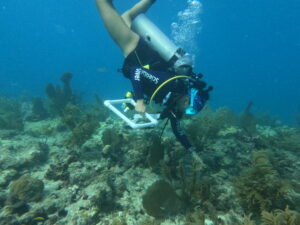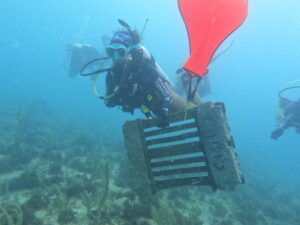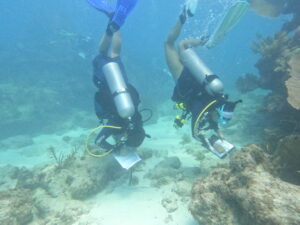When I arrived in Summerland Key, FL, I remember feeling nervous. It was my first year in SCUBANauts and I only really knew two people there. As the van pulled up to the building we’d be staying at; The Mote Marine Laboratory, the nervousness quickly got overpowered by excitement.
The facility was incredible. It was the Elizabeth Moore International Center for Coral Reef Research & Restoration. I felt that it held a collegiate atmosphere to it. On the first floor there were specialized coral nursery tanks where fragments of Staghorn and Elkhorn coral were carefully housed under conditions manufactured to mimic the ocean. To the left of that were tanks that held live king crabs that were being reinstated to the ocean in order to eat the algae. From the start of the trip I was being exposed to new things and learning so much.
To my pleasure that pattern continued throughout the following week. My week at Summerland Key with SCUBAnauts was incredible and unlike anything I’d experienced before. This experience would enrich my knowledge of marine science and my responsibility as an ocean steward.

Aracely straightens her benthic transect line with a quadrat in hand.
AGRRA Benthic Surveys – Understanding Changes on the Reef
Every day brought new diving adventures and hands-on scientific learning. During our benthic survey dives, I learned how to identify organisms across the reef scape using the AGRRA system.
We swam along transect lines with underwater clipboards recording coral cover and other substrate types. I got to experience what surge felt like below the surface and practiced using only my fins to stay in place while my hands were occupied recording data. With the added challenge of carrying science tools, I was able to perfect my buoyancy and trim. What I found really cool was that every dive wasn’t just recreational– we were conducting real scientific research.
In doing so we got to work with actual marine scientists at MOTE. MOTE has a coral tree farm in the open ocean. All of the coral trees there are made of PVC and on the “branches” hang fragments of coral. Once the fragments are more mature they are out planted by MOTE to degraded reefs.
On two
mornings of our trip we went on coral restoration dives and were able to assist in coral tree cleaning. The trees often struggle with algae and other organisms, which grows over and smothers them. If these are left unchecked it can be detrimental to the corals health because if overrun by algae the coral can’t photosynthesize and get the nutrients it needs to survive.
During our coral tree cleaning dives, I carefully removed algae and sediment from coral fragments using small wire brushes and pliers. Luckily none of the algae we scraped off went to waste; there were plenty of yellowtail snappers camped around the trees eagerly awaiting the falling debris. You could tell that they were used to seeing divers around there because all the snappers were super friendly and would swim right up to your mask.

Aracely uses a lift bag to carry a heavy piece of debris back to the boat near Key West.
Goal: Clean Seas
Another thing I really enjoyed was the debris cleanup dives. With support from the NOAA Goal: Clean Seas initiative, we aided in removing fishing line and other trash that threatened marine life from the reefs in Key West. On the first debris dive I found a fragment of a wooden crate. It was super heavy because it had concrete pieces attached to the beams, so I used a lift bag, which is a bag that you attach to heavy debris and then fill with air so that the object is lighter.
One of my favorite moments from the trip was watching the documentary “Ocean” with David Attenborough during one of our afternoon science lessons. It was different from the PowerPoints, project work, or data entry that we normally focused on during that time—it was a reflective moment.
The film itself left me both in awe and disturbed. I learned a lot from it. Firstly, the beauty of the ocean really struck me. Reefs untouched by mankind flourish; so much so that one speaker in the film compared the splendor to that of “The Garden of Eden.” Every single organism is reliant on every other one-interconnected.
In the ocean predator is no
better than prey; without one there is no other. These are realities that marine life has respected because their survival depends on it.
The film made me aware of how much we as humans have ignored this actuality through things like bottom trawling nets. I knew it was bad, but seeing a visual of these weighted nets dragging along the ocean floor, taking out ecosystems that had been there for centuries in seconds, shook me. It made me upset because I realized that we’ve been terrible stewards of our ocean.
After the documentary was over, we all took a minute to write our thoughts in our journals and then we discussed the film.

Aracely and her buddy record data during a dive on Looe Key.
A Generation for Change
Understanding the reality of
the condition of the Ocean that my generation has been handed was unfortunate, but more than anything, as we went around the room sharing out takeaways from the film, hearing how passionate other Nauts were about saving it filled me with determination.
Everything that we had taken part of the past week was already a huge step towards helping the ocean recover; the coral work, the data collection, and the debris cleanup dives.
SCUBAnauts has done more than educate me about marine sciences—it has given me a community of likeminded thinkers and people I now consider my best friends, and I know that we are all working towards protecting our oceans.
— Aracely G., Naut-in-Training, Orlando Chapter




